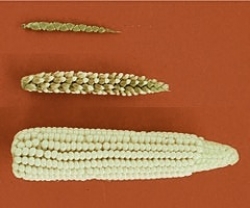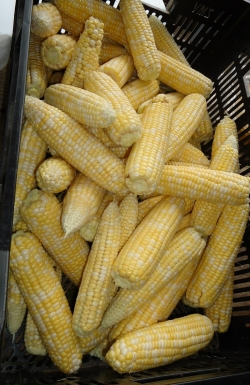Hungry? Here, chew on this one-inch, rock-hard cylinder. Don't want to? Why not? It's edible. It's a plant. Still no, huh? What if I were to tell you that after some changes, the thing you're holding in your hand is in one out of every three packaged foods in the grocery store? At least in one form or another. What changes would have to happen to something in order for it to transform from something you can barely eat to a food found everywhere? The thing you're holding in your hand . . . is corn.
Well . . . it's kind of corn. What you hold in your hand is corn before it became the corn we know today. Nature made this dark, hard little thing you cannot eat over many, many years ago. It didn't start out small and hard, but it slowly changed over time. This little plant has been around for a long time because people have been eating it for thousands of years! Natural selection is when the living things that are better at surviving will have a better chance to reproduce. Every living thing around us has changed over time. If something cannot survive, it will die and will not be able to have offspring (make babies). As some things live and some survived better, the types of living things that we see around us will always change. The plant that made this early corn is the product of millions of years of changes. You might not want to eat it right now, but people found a way long ago . . .
So what was this small and hard corn before it was the corn we eat today? Nature may have changed it a bit, but the main reason that corn is so large and delicious today is that people made it that way. Teosinte is a wild grass that changed over time into the large yellow corn that we know today. Both nature and people helped this grass to change into maize, which is another word for corn. Maize was very important to many native American cultures. They ground it up and used the powder to make bread and other foods. They also used the dried husks to make things like baskets and mats. The ears came in all colors, red, blue, and white. The plant became so important, in fact, that people decided to take the reins away from nature and start making some changes themselves.

Teosinte, it's what's for dinner?
As I said before, not all corn looked the way it does today and people wanted the biggest and best food they could get. If a plant grows bigger ears, they would have more food. By only planting the seeds from the best plants, we took over for nature and started choosing which corn plants would pass on their genes. Selective breeding is when people choose what living things get to make new offspring. We always choose the ones that make us happiest. We do it with many more things than just corn""like other plants, and animals, like dogs""but corn has made the biggest changes and has a very big effect on our lives. We changed corn so much, it doesn't even grow in the wild anymore.

It may have taken some time, but corn really came a long way.
John Doebley, CC BY 3.0 , via Wikimedia Commons
So what began as a plant that people did not have much use for, is now in one out of every three foods you can find at the store. Nature first made corn through natural selection, killing off any plants that did not survive, leaving room for the plants that could survive to pass on their seeds. Maize was so important to Native Americans that they began to choose which plants would pass on their seeds in something called artificial selection. This was how people took over for nature. Artificial selection is when people change how living things pass on genes or seeds, and making them change over time. So now do you want to eat that one-inch hard . . . thing? I do not blame you. Let's go to the store and get some corn.

Corn on the cob. Now that's what I'm having.
Tomwsulcer, CC0, via Wikimedia Commons
Fun Fact! Wait! You might be thinking that you don't see corn in any products at the grocery store. That's because it's been changed many ways to take on different forms, from sweetener to filler to plastics!
References:
Camp Silos. "History of Corn" campsilos.org, 2013. <http://www.campsilos.org/mod3/students/c_history.shtml>
Genetics. "The Evolution of Corn" utah.edu, 2014. <http://learn.genetics.utah.edu/content/selection/corn/>
Iowa State. "Origin, History, and Uses of Corn" iastate.edu, 2010. <http://agron-www.agron.iastate.edu/Courses/agron212/readings/corn_history.htm>